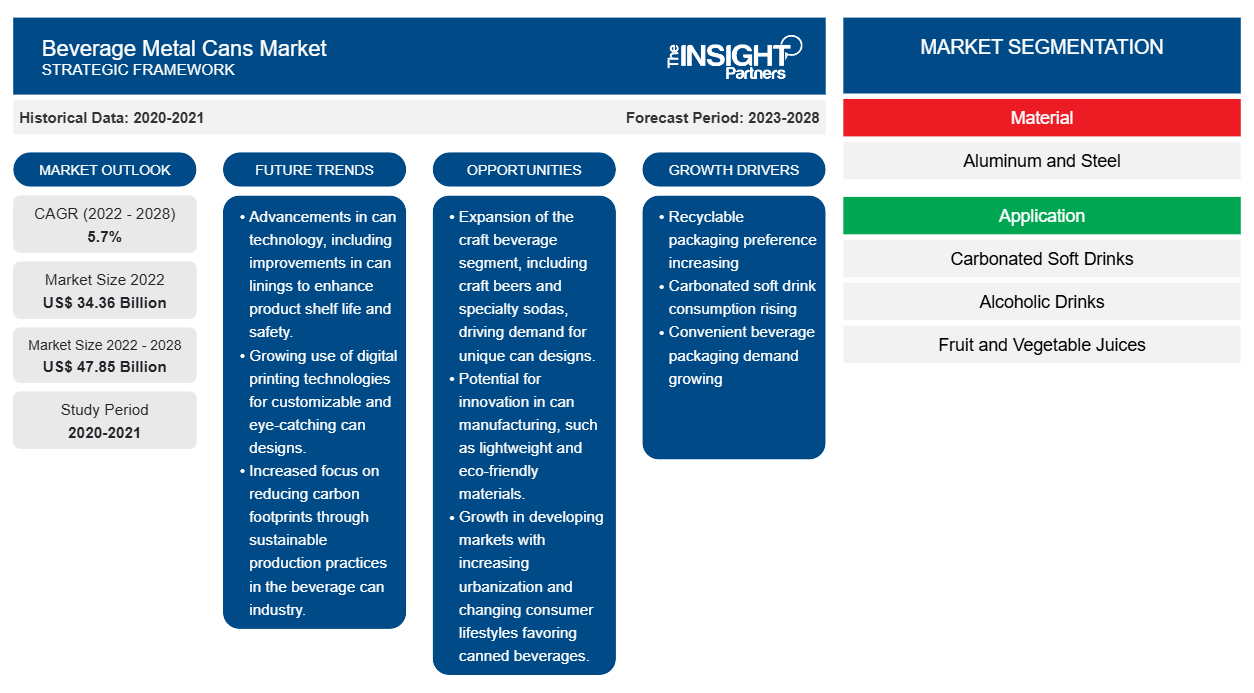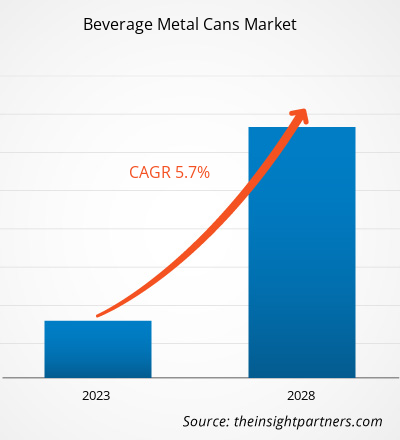음료용 금속 캔 시장은 2022년 343억 6,314만 달러에서 2028년에는 478억 5,242만 달러로 성장할 것으로 예상되며, 2022년부터 2028년까지 연평균 성장률 5.7%로 성장할 것으로 예상됩니다.
시장 성장은 전 세계적으로 환경에 대한 인식이 빠르게 높아지고 있는 데 기인합니다. 따라서 플라스틱 포장재를 재활용 가능하고 환경 친화적인 금속 또는 유리 포장재로 대체하기 위한 다양한 정부 규제가 시행되고 있습니다. 음료 금속 캔의 전체 탄소 발자국은 플라스틱 포장재보다 낮은데, 이는 원료를 재활용 재료에서 얻을 수 있고 플라스틱과 달리 처녀 원료가 필요하지 않기 때문입니다. 또한, 금속 포장재는 내구성이 뛰어나 식음료 산업에 사용하기에 안전한 것으로 간주됩니다.
2021년 북미는 전 세계 음료 금속 캔 시장 에서 가장 큰 점유율을 차지했습니다 . 그러나 아시아 태평양 지역은 예측 기간 동안 시장에서 가장 높은 CAGR을 기록할 것으로 예상됩니다. 아시아 태평양 시장은 중국, 인도, 일본, 한국, 호주로 세분화됩니다. 한국, 중국, 일본과 같은 국가는 주요 식음료 시장 중 하나입니다. 이 지역은 또한 포장 음료에 대한 국내 수요 증가로 인해 성장하고 있는 수많은 식음료 제조업체의 본거지이기도 합니다. 아시아 태평양 지역에서 음료 생산량이 증가하고 재활용 가능한 포장재에 대한 선호도가 높아짐에 따라 예측 기간 동안 해당 지역의 시장 성장이 촉진될 것으로 예상됩니다.
이 보고서의 일부 또는 국가 수준 분석, Excel 데이터 팩을 포함하여 모든 보고서에 대한 사용자 정의를 무료로 받을 수 있으며, 신생 기업 및 대학을 위한 훌륭한 혜택과 할인도 이용할 수 있습니다.
음료용 금속 캔 시장: 전략적 통찰력

-
이 보고서에서 주요 시장 동향을 알아보세요.이 무료 샘플에는 시장 동향부터 추정치 및 예측까지 다양한 데이터 분석이 포함됩니다.
COVID-19 팬데믹이 음료용 금속 캔 시장에 미치는 영향
코로나19 팬데믹은 여러 지역에 걸친 장기 봉쇄, 제조 시설 폐쇄, 여행 제한, 국제 무역 및 공급망 제한, 원자재 공급 부족 등으로 제조업 부문의 운영 효율성에 상당한 차질을 빚었습니다. 팬데믹은 제조 시설 폐쇄, 원자재 가격 상승, 노동력 부족, 공급망 차질, 금융 불안정으로 시장에 부정적인 영향을 미쳤습니다. 더욱이 코로나19 확산으로 인한 경기 침체로 식음료 산업이 타격을 입으면서 시장 성장이 저해되었습니다. 그러나 여러 국가에서 기존에 시행되었던 제한 조치가 완화되면서 기업들은 성장세를 회복하고 있습니다. 또한, 각국 정부가 코로나19 백신을 도입하면서 상황이 완화되어 전 세계적으로 사업 활동이 증가했습니다. 나아가 각국 정부는 팬데믹의 경제적 영향을 완화하기 위해 현대적이고 기술적으로 진보된 인프라 구축을 계획하고 있습니다. 봉쇄 기간 동안 소비자들은 식음료 대신 포장 식품과 음료를 많이 구매했습니다. 따라서 COVID-19 팬데믹의 부정적인 영향에도 불구하고 음료용 금속 캔 시장은 앞으로 몇 년 안에 상당한 성장을 이룰 것으로 예상됩니다.
시장 통찰력
탄산음료의 높은 소비
탄산음료는 소비자의 취향과 맛 선호도에 맞춰 만들어지며, 이러한 제품은 최근 건강을 의식하는 소비자를 위한 기능성 음료로 탄생했습니다. 탄산 음료는 제조업체들의 지속적인 신메뉴 출시로 소비자들 사이에서 인기가 높아지고 있습니다. 클린 라벨, 글루텐 프리, 저칼로리, 저탄수화물 제품에 대한 수요 증가로 탄산음료 수요가 급증했습니다. 금속 캔은 탄산음료 포장재로 널리 사용됩니다. 소비자들은 새롭게 출시된 탄산음료가 장기적으로 건강에 해로운 성분을 포함하지 않고, 엄선된 재료를 통해 신체적, 정신적 건강을 증진시키기를 기대합니다. 저당 음료와 스트레스 해소 효과가 있는 제품은 앞으로도 소비자들에게 큰 인기를 누릴 것으로 예상됩니다. 기능성 음료 산업이 성장하고 소비자들의 건강에 대한 관심이 높아짐에 따라 건강 음료에 대한 관심도 높아지고 있습니다. 월마트나 편의점 등에서 저칼로리 또는 제로칼로리 음료를 쉽게 구할 수 있게 되면서 탄산음료 소비가 급증했습니다. 따라서 탄산음료에 대한 수요와 소비 증가는 금속 캔 음료 시장의 성장을 견인하고 있습니다.
애플리케이션 인사이트
전 세계 음료용 금속 캔 시장은 용도에 따라 탄산음료, 알코올음료, 과일 및 채소 주스 등으로 구분됩니다. 2021년에는 알코올음료 부문이 가장 큰 시장 점유율을 차지했습니다. 알코올음료는 베리류, 과일, 곡물, 그리고 식물 수액, 덩이줄기, 꿀, 우유와 같은 기타 성분에 함유된 당분을 발효시켜 만듭니다. 증류를 통해 원래의 묽은 액체를 훨씬 높은 알코올 도수의 액체로 바꿀 수 있습니다. 또한, 휴대용 용기에 대한 수요 증가는 알코올음료 부문의 성장을 촉진하고 있습니다. 전 세계 소비자들의 변화하는 업무 습관으로 인해 캔 알코올음료 시장도 성장할 것으로 예상됩니다. 캔 포장은 음료의 섬유질 함량을 유지하여 품질을 저하시키지 않고 유통기한을 연장할 수 있어, 기능성이 뛰어난 음료를 생산하는 음료 제조업체에게 필수적인 선택입니다.
Ball Corporation, Crown Holdings, Inc., Ardagh Group SA, CANPACK, Orora Packaging Australia Pty Ltd, Amcor plc, Silgan Containers LLC, ZI Industries Limited, SHOWA DENKO KK, 그리고 Envases Group은Ardagh Group S.A.; CANPACK; Orora Packaging Australia Pty Ltd; Amcor plc; Silgan Containers LLC; ZI Industries Limited; SHOWA DENKO K.K.; and Envases Group 음료용 금속 캔 시장에서 활동하는 주요 기업입니다. 이 회사들은 시장에 광범위한 제품 포트폴리오를 제공합니다. 개발도상국에 진출해 있는 이 회사들은 음료용 금속 캔 시장 성장에 수익성 높은 기회를 제공합니다. 시장 참여 기업들은 고객의 요구를 충족하는 고품질의 혁신적인 제품을 개발하고 있습니다.
음료용 금속 캔 시장 지역별 통찰력
The Insight Partners의 분석가들은 예측 기간 동안 음료용 금속 캔 시장에 영향을 미치는 지역별 동향과 요인들을 면밀히 분석했습니다. 이 섹션에서는 북미, 유럽, 아시아 태평양, 중동 및 아프리카, 그리고 중남미 지역의 음료용 금속 캔 시장 부문과 지역별 분포도 살펴봅니다.
음료용 금속 캔 시장 보고서 범위
| 보고서 속성 | 세부 |
|---|---|
| 2022년 시장 규모 | 343억 6천만 달러 |
| 2028년까지 시장 규모 | 478억 5천만 달러 |
| 글로벌 CAGR(2022~2028년) | 5.7% |
| 역사적 데이터 | 2020-2021 |
| 예측 기간 | 2023-2028 |
| 다루는 세그먼트 |
재료별
|
| 포함된 지역 및 국가 |
북아메리카
|
| 시장 선도 기업 및 주요 회사 프로필 |
|
음료용 금속 캔 시장 참여자 밀도: 비즈니스 역학에 미치는 영향 이해
음료용 금속 캔 시장은 소비자 선호도 변화, 기술 발전, 그리고 제품의 효능에 대한 인식 제고 등의 요인으로 인한 최종 사용자 수요 증가에 힘입어 빠르게 성장하고 있습니다. 수요가 증가함에 따라 기업들은 제품 라인업을 확장하고, 소비자 니즈를 충족하기 위한 혁신을 추진하며, 새로운 트렌드를 적극 활용하고 있으며, 이는 시장 성장을 더욱 가속화하고 있습니다.

- 음료용 금속 캔 시장의 주요 주요 업체 개요를 확인하세요
스포트라이트 보고서
- 음료 금속 캔 시장의 진보적인 산업 동향은 플레이어가 효과적인 장기 전략을 개발하는 데 도움이 됩니다.
- 선진국과 개발도상국 시장에서 채택된 사업 성장 전략
- 2019년부터 2028년까지 음료용 금속 캔 시장에 대한 정량적 분석
- 음료용 금속 캔에 대한 글로벌 수요 추산
- 산업에서 운영되는 구매자와 공급자의 효율성을 설명하기 위한 포터의 5가지 힘 분석
- 경쟁 시장 시나리오를 이해하기 위한 최근 개발
- 음료용 금속 캔 시장 성장을 촉진하고 제한하는 요인과 더불어 시장 동향 및 전망
- 상업적 이익을 뒷받침하는 시장 전략을 강조하여 의사 결정 과정을 지원하고 시장 성장을 이끕니다.
- 다양한 노드에서의 음료용 금속캔 시장 규모
- 시장의 자세한 개요 및 세분화, 그리고 음료 금속 캔 산업 역학
- 유망한 성장 기회를 갖춘 다양한 지역의 음료용 금속 캔 시장 규모
"2028년까지의 글로벌 음료 금속 캔 시장 분석"은 화학 및 재료 산업에 대한 전문적이고 심층적인 연구 로, 특히 글로벌 음료 금속 캔 시장 동향 분석에 중점을 두고 있습니다. 본 보고서는 상세한 시장 세분화를 통해 시장 개요를 제공하는 것을 목표로 합니다. 음료 금속 캔 시장은 재료, 용도, 그리고 지역을 기준으로 세분화됩니다. 재료별로는 알루미늄과 강철로, 용도별로는 탄산음료, 알코올 음료, 과일 및 채소 주스 등으로 세분화됩니다. 지역별로는 북미, 유럽, 아시아 태평양(APAC), 중동 및 아프리카(MEA), 그리고 중남미로 크게 세분화됩니다.
회사 프로필
- 볼 코퍼레이션
- 크라운 홀딩스 주식회사
- 아르다그 그룹 SA
- 캔팩
- 오로라 패키징 오스트레일리아 Pty Ltd
- 암코르 주식회사
- 실간 컨테이너스 LLC
- ZI 산업 유한회사
- 쇼와덴코(주)
- 엔바세스 그룹
- 과거 분석(2년), 기준 연도, CAGR을 포함한 예측(7년)
- PEST 및 SWOT 분석
- 시장 규모 가치/거래량 - 글로벌, 지역, 국가
- 산업 및 경쟁 환경
- Excel 데이터세트
최근 보고서
관련 보고서
사용 후기
구매 이유
- 정보에 기반한 의사 결정
- 시장 역학 이해
- 경쟁 분석
- 고객 인사이트
- 시장 예측
- 위험 완화
- 전략 기획
- 투자 타당성 분석
- 신흥 시장 파악
- 마케팅 전략 강화
- 운영 효율성 향상
- 규제 동향에 발맞춰 대응






















 무료 샘플 받기 - 음료용 금속 캔 시장
무료 샘플 받기 - 음료용 금속 캔 시장